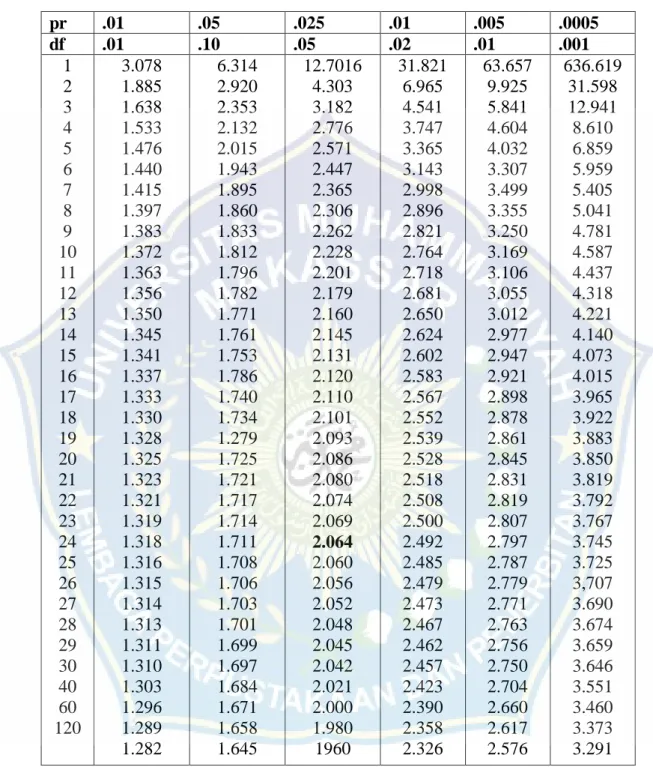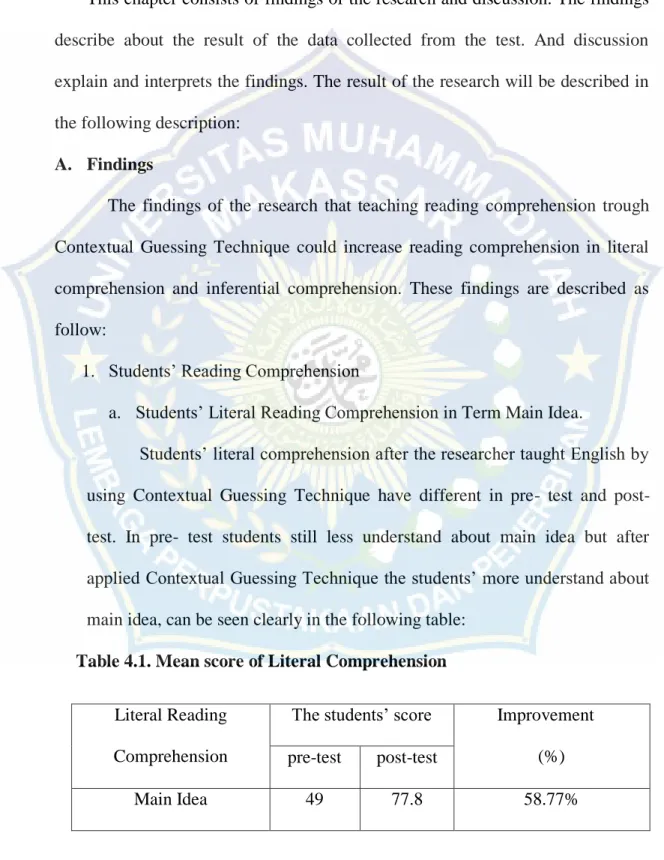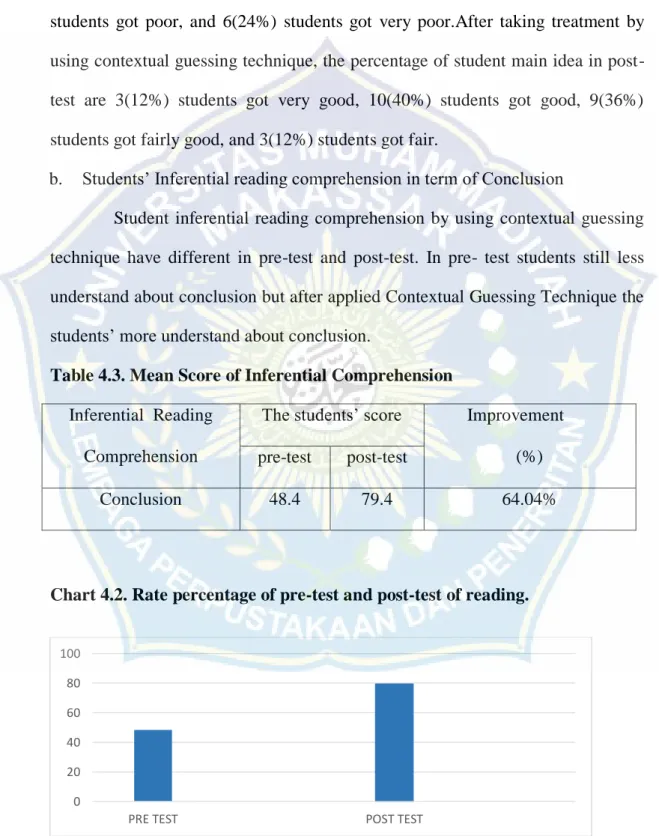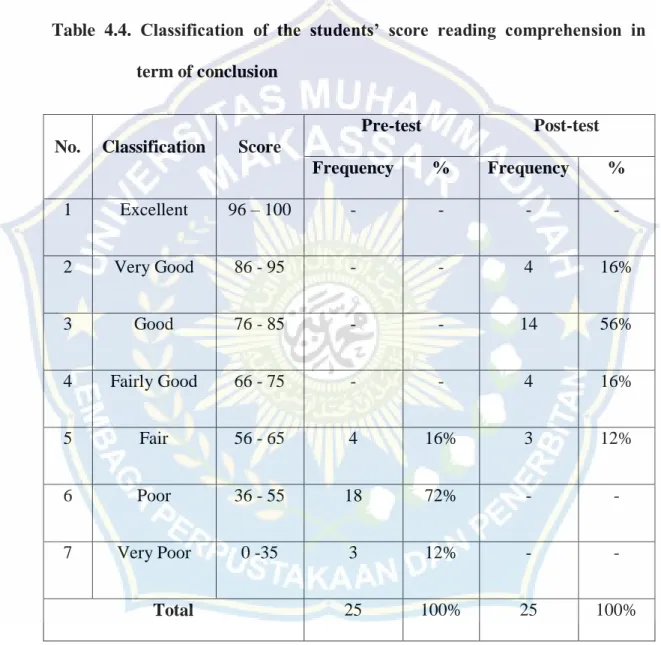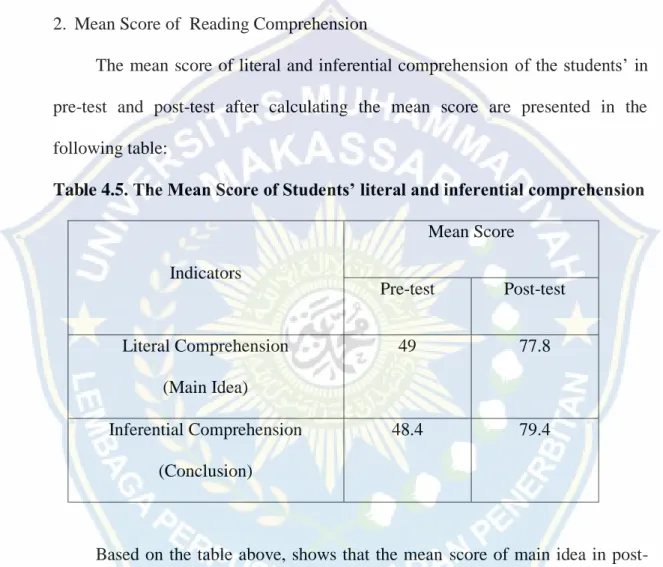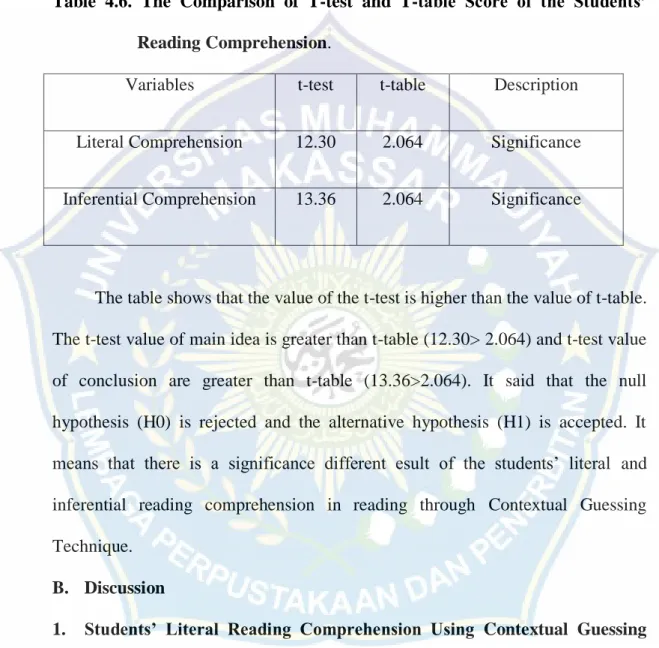Proposal by Judul: Application of Contextual Guessing Technique to Improve Students' Reading Comprehension in Second Year of SMP Negeri 4 Baraka. Erwin Akib, M.Pd.,Ph.D the Dean of FKIP Muhammadiyah University of Makassar for all advice and motivation. Application of Contextual Guessing Technique to Improve Students' Reading Comprehension in the Second Year of SMP Negeri 4 Baraka (Pre-Experimental Research).
The result showed that the literal and inferential understanding in pre-test and post-test differ significantly. The mean score of literal comprehension in post-test was higher than pre-test (77.8>49) and the mean score of inferential comprehension in post-test than pre-test (79.4>48.4). Hasil peresikaan sempakat bahwa permanesan literal dan inferential pada Pre-test and Post-test memiliki perbadanan yang signifikant.
Nilai rata-rata pemahaman literal pada Post-Test lebih tinggi dibandingkan Pre-Test (77.8>49) dan nilai rata-rata pemahaman inferensial pada Post-Test lebih tinggi dibandingkan Pre-Test (79.4>48.4 ).
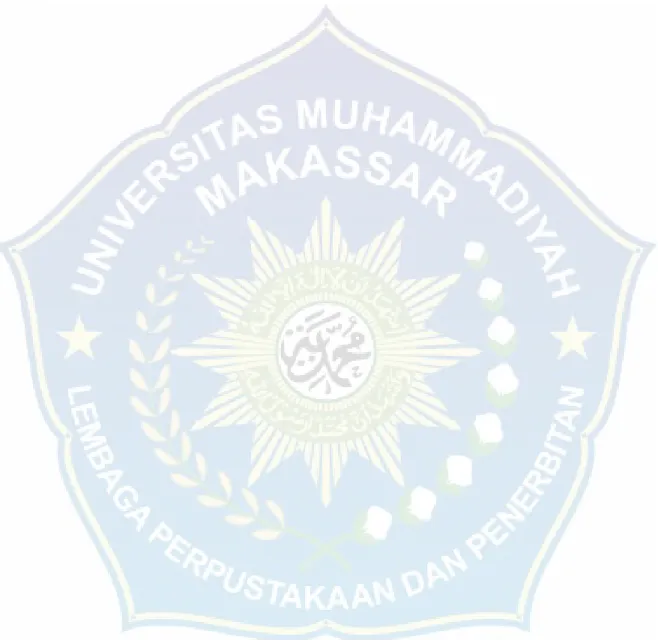
Background
According to Burhan, reading is a physical and mental activity to reveal the meaning of the written texts, while in that activity there is a process of knowing letters. He then concludes that the main purpose of reading is a process of comprehending written texts. The teachers only present the topic of the textbook reading and ask the students to read aloud, and then answer the questions in the text.
Based on the above descriptions, the researcher will describe about the Contextual Guessing Technique, which is designed to help students use context to unlock the meaning of unknown words and guess about words. So this technique can help students to know how to guess unknown words in context. Through one of the techniques that will be used, it is useful to motivate students to improve their reading comprehension.
Based on the above statement, the researcher decides to conduct research on "Using Contextual Guessing Technique to Improve Students' Reading Comprehension in Second Year of SMP Negeri 4 Baraka".
Problem Statement
Objective of The Research
Significance of the Reseach
Scope of the Research
REVIEW OF RELATED LITERATURE
- Previous Related Research Finding
- Definition of ReadingTypes of Reading
- Types of Reading
- Purpose of Reading
- Reading is Important
- Reading Comprehension
- Definition of reading comprehension
- The Factors that Influence Reading Comprehension
- Skills Reading Comprehension
- Contextual Guessing Technique
- Conceptual Framework
The reader tries to know what interests the subject and the problem of the story. The reader tries to classify some information or action of the writer in the text or paragraph. It is one of the most important tools we use every day to connect with each other.
As students read, they can determine the main idea and supporting detail, the sequence of events, and the overall structure of the text. However, according to Carnine, et.al (1997), literal questions can be very difficult depending on the length of the text. Although dictionary use can increase the accuracy and precision of the meaning of unfamiliar words, it slows down students' reading comprehension (Knight, 1994).
Contextual guessing is defined as an important strategy in the absence of dictionaries or human assistance and it "involves guessing the meaning of target word based on interpretation of its immediate context with or without reference to knowledge of the world.
RESEARCH METHOD
- Research Design
- Population and Sample
- Research Variables and Indicators
- Instrument of the Research
- Procedure of Data collection
- Technique of Data Analysis
After collecting the students' data, the researcher classified the students' scores. The table and graphic above shows that there was an improvement in students' reading comprehension in terms of literal comprehension from the pre-test with the mean score being 49 and the post-test being 77.8. The table and graphic above shows that there was an improvement in students' reading comprehension in terms of inferential comprehension from pre-test with the mean score being 48.4 and post-test being 79.4.
It means that there is a different understanding of the meaning of literal reading and students' inference in reading through the technique of contextual inference. The description of the data collected through the pre-test, as explained in the previous section, shows that the students' literal reading comprehension has improved. After you have calculated the students' scores for the literal reading comprehension indicator in the pre-test and post-test, explain the students' classification.
The score of the students in the post-test is higher than the score of students in the pre-test. Therefore, it can be concluded that the contextual guessing technique can improve the students' understanding in literal reading comprehension. After calculating the students' score of the indicator of inferential reading comprehension in pre-test and post-test, also explain the classification of students'.
Therefore, we can conclude that the contextual guessing technique could improve students' comprehension in inferential reading comprehension. By observing the effectiveness of students' literal and inferential comprehension in reading skills. The conclusion is that the contextual guessing technique improves students' comprehension in both literal and inferential reading.
The average score of the students on the pre- and post-test in reading for literal comprehension. The average score of the students on the pre- and post-test in reading for inferential comprehension.
FINDINGS AND DISCUSSION
Findings
The findings of the research that teaching reading comprehension by means of contextual guessing technique can increase reading comprehension in literal comprehension and inferential comprehension. Students' literal comprehension after the researcher taught English using contextual guessing technique differed in pre-test and post-test. Students' inferential reading comprehension using contextual guessing technique differs in pre-test and post-test.
In the pretest, the students still understand the conclusion less, but after using the contextual guessing technique, the students understand the conclusion more. After treatment using the contextual guessing technique, the percentage of students' conclusions in the posttest is: 4 (16%) students scored very well, 14 (56%) students scored well, 4 (16%) students scored fairly well, and 3 (12%) ) students received fairly. Based on the table above, it can be seen that the average score of the main idea in the post-test is higher than in the pre-test (77.8>49) and that the main score of reasoning in the post-test is higher than in the pre-test (79.4> 48.4).
It is a test to know the significance of the difference between the result of students' average scores in pre- and post-test. The table shows that the value of the t-test is higher than the value of the t-table.
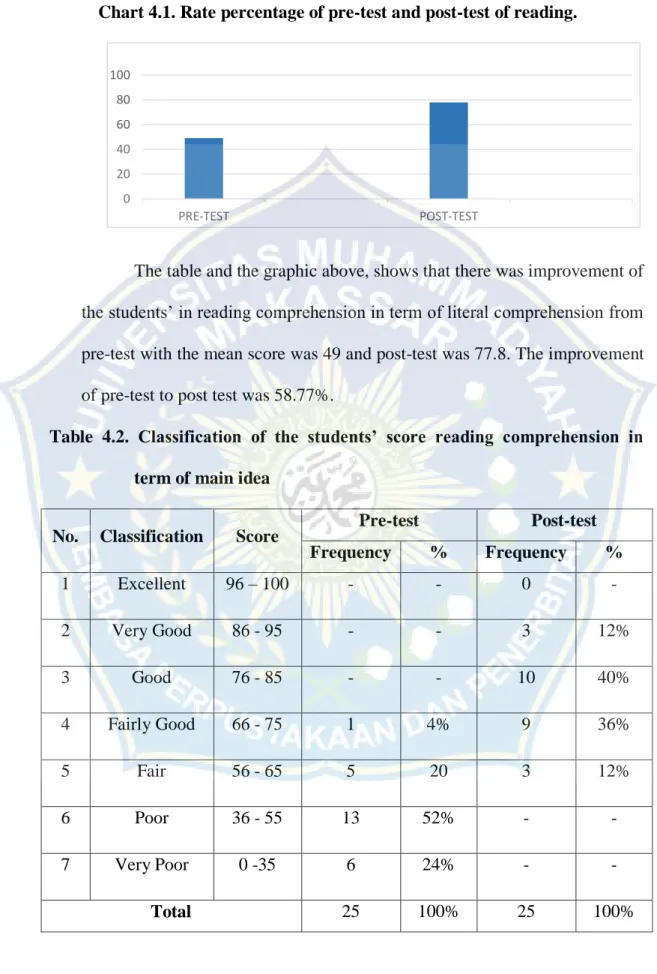
Discussion
Idawati (2009) conducted her research. Use of Contextual Guessing was better than when they were taught using other techniques to improve the students' reading comprehension. Based on the findings above, shows that the students' literal reading comprehension is supported by the average score of students on pre-test and post-test in main idea is 49 and 77.8. Before applying contextual guessing technique, the students could not decide clearly identified main idea by providing strong evidence, details related to the main idea.
Reading comprehension inference involves the process of thinking such as drawing conclusions, generalizing, and predicting results (Cate, Jane, Marcia, & . Peter, 2001). In the conduct of Irawati (2006), her research also concludes that there is a significant difference between reading comprehension before and after using communicative tasks. From the above findings, it results that the students' reading comprehension is supported by the average score of the students in the pre-test and post-test in the main idea is 48.4 and 79.4.
Before applying the contextual guessing technique, it was difficult for the students to draw conclusions or to represent the sources they had read in the development idea. But after applied contextual guessing technique, the students can easily come to conclusions and understand the moral meaning of the text. By the result of the pre-test and post-test, the result of the t-test value of the level of the significant = 0.05, the degree of freedom (df) = 25 indicated that the t-table value is 2.064.
The students' reading test and post-test showed that some students had difficulty answering the question and finding the main idea and conclusion. But the reading comprehension of the students in the post-test, which made it possible to understand the content of reading comprehension, and it was easy to answer the question and find out the main idea and conclusion. From the above discussion, it can be concluded that the students of the second year students of SMP Negeri 4 Baraka can argue that the use of Contextual Guessing Technique is very effective in improving the reading comprehension of the students.
Conclusion
Suggestion
Improving the reading comprehension of first year students at SMA Negeri 1 Makassar through communication task. One day the blue-tongued lizard went out to get food, and while he was in the swamp, he left his wife sitting under a shady tree. He hadn't been there very long when the Snake Taipan passed by the camp of the Blue Tongue Lizard.
Taipan saw Blue-tongued lizard's wife sitting under the tree and he decided to steal her away from Blue-tongued lizard. Taipan the Snake did not know that Black Bird had been watching him, and as soon as he ran away with Blue Tongue Lizard's wife, Black Bird began to sing along to Blue Tongue Lizard. Blue-tongued Lizard was still feeding in the swamp when he heard Black Bird's call.
Blue-tongued lizard followed their tracks until it came to a tree in which a freshly killed emu was hung. Blue-tongued lizard knew that Taipan and his wife had to be nearby and he soon found them near a river. When Taipan saw Blue-tongued Lizard, he ran to get his spears, but Blue-tongued Lizard had already broken them.
The taipan agreed and the two fought wildly, each trying to catch the other. Until finally the blue tongue lizard caught the Taipan's body in its powerful jaws and bit it in half. With Taipan Snake dead, Blue-Tonge took his wife and together they returned to the swamp.
The Black Bird began to sing to the Blue Tongue Lizard about the Taipan Snake and his wife. According to the passage, all of the following are true about the blue-tongued lizard except. According to the passage, why do you think the blue tongue lizard ate a meal before he went to look for his wife.
Not far away is the stump of a tree felled by Sangkuriang, now called BukitTinggi.
